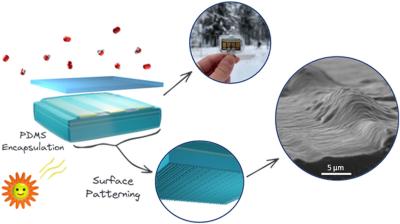Researchers at Finland's Aalto University and Tampere University have developed an encapsulation method for perovskite solar cells (PSCs) to address both optical performance losses at the air-cell interface and intrinsic and extrinsic stability challenges. The team's one-step method provides PSCs with shielding from oxygen and moisture-induced degradation as well as in situ patterning for light management.
In the new method, the entire surface and sides of the solar cells were coated with polydimethylsiloxane (PDMS), and the front-facing surface of the PSC was in situ–patterned using a soft lithography technique. A replica of leek leaf surface structures was created on the PDMS to reduce reflection and increase haze. The scientists explained that leek leaf replicas, previously used as add-on layers for PSC devices, have shown promise due to their optical and self-cleaning properties.
To evaluate the effects of encapsulation and patterning, the devices were first encapsulated, and their performance and stability were assessed. Then, the performance was reassessed after adding the leek leaf surface structure to the front side.
It was reported that this unified approach of combining encapsulation and surface patterning not only provided a barrier against oxygen and moisture but also simultaneously improved solar cell efficiency by reducing reflection and increasing haze.
As a result of embedding the antireflective coating onto the front side of the cell, the power conversion efficiency (PCE) of the PSCs was increased from 14.1 ± 0.8 % to 15.6 ± 0.8 %, indicating an 8 % relative improvement. Moreover, the encapsulated devices kept their initial performance after 90 % relative humidity and water immersion tests. The outdoor exposure test showed no degradation for the encapsulated cells after 24 h of resting at −17 °C and maximum wind speeds of 7 m/s on average. Additionally, the encapsulation strategy was instrumental in mitigating oxygen and humidity-induced degradation during ISOS-LC tests, retaining up to 80 % of the initial performance for the encapsulated devices after 360 h.
This research highlights in situ encapsulation and patterning as a promising solution for reducing optical losses and extrinsic instabilities in PSCs. The choice of flexible encapsulant enables it to be used for both rigid and flexible PSCs in a wide range of applications.




